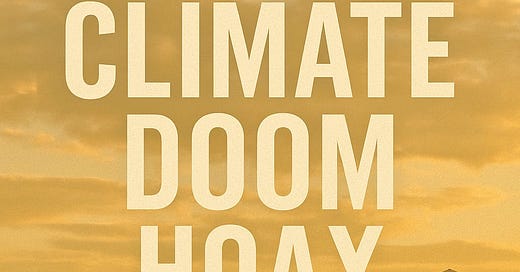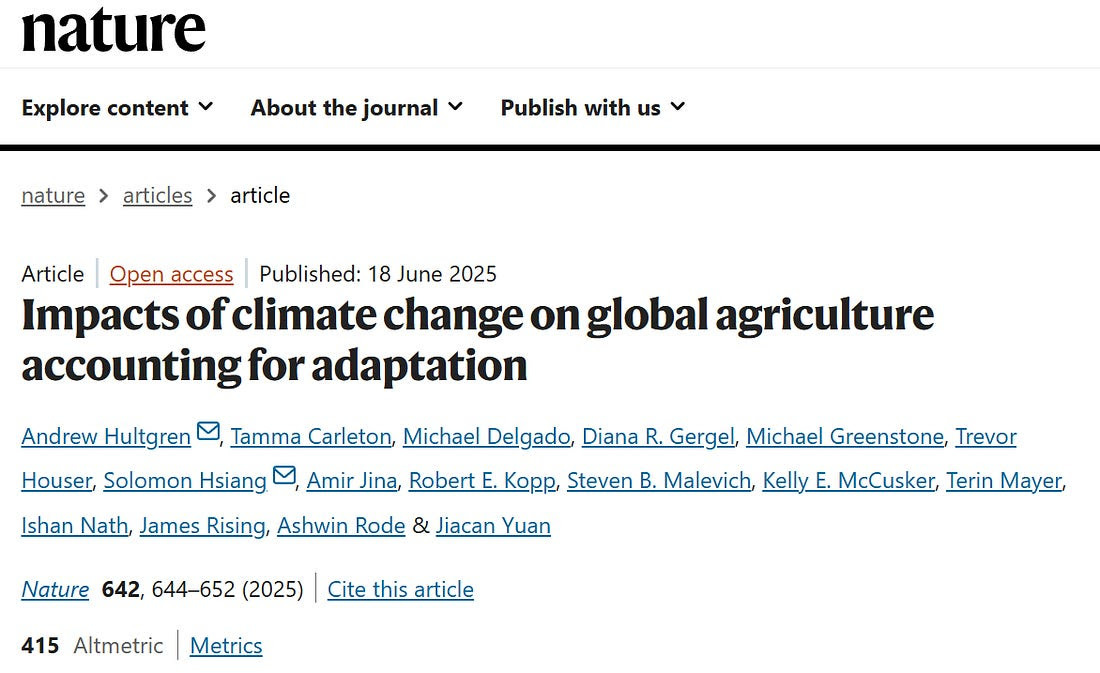HEADLINE: “The Latest Climate Pivot: From Warming to Agricultural Ruin”, By Dr. Mathew Wielicki
“Here we go again. As public interest wanes in the endless parade of climate doom, first global warming, then extreme weather, activists and complicit media have pivoted once more.”
The Latest Climate Pivot: From Warming to Agricultural Ruin
Here we go again. As public interest wanes in the endless parade of climate doom, first global warming, then extreme weather, activists and complicit media have pivoted once more. Their latest scare? Subtle warming and rising CO₂, proven to boost crop yields and green the planet, will somehow trigger agricultural collapse. It’s the same tired, debunked narrative, repackaged as ‘groundbreaking’ science.
I've extensively dissected these narratives before. For instance, I've detailed how NASA's own data undermines claims of crop devastation, showing global production of staple crops like rice, wheat, and corn surging approximately 50% since the mid-1990s, precisely when warming is said to have accelerated dramatically. Notably, rice production skyrocketed without significant expansion in cultivated land, proving the tangible benefits of CO₂ fertilization and agricultural innovation.
Similarly, my critique of IPCC predictions spotlighted how their 2007 forecast of agricultural collapse in Africa failed spectacularly. Instead of a predicted 50% yield reduction, agricultural output in regions like the Sahel, East Africa, and Southern Africa soared. Ethiopia alone increased agricultural output by nearly 64% since 2007.
Additionally, I've thoroughly discussed the critical role of synthetic fertilizers made from fossil fuels, essential in sustaining nearly half of the world's population.
Yet, despite these repeated failures, prestigious journals like Naturecontinue publishing papers that echo the same unfounded fear-mongering. Why? It's simple, fear fuels funding. Activist scientists, universities, and research institutions profit from a perpetual state of alarm. The more dire their predictions, the richer the rewards.
This brings us to the latest paper published in Nature, predicting massive agricultural disruption due to climate change, echoing the IPCC's discredited claims from 2007.
It's a perfect case study in how "scientific" narratives are manipulated to perpetuate irrational climate fears. The models behind these predictions are contrived. They selectively tune variables to deliver alarmist outcomes while blatantly ignoring observational realities.
Why This Paper is Just More Climate Propaganda
Here's the real kicker, the new Nature paper isn't groundbreaking science, it's recycled nonsense. If you've followed my previous writings, you already know what to expect, carefully orchestrated doom, selective data omission, and a complete disregard for observable agricultural trends.
Notably, this research was heavily funded by influential organizations, including the Carnegie Corporation, the Energy Policy Institute at the University of Chicago, the Sloan Foundation, and several philanthropic entities like the Heising-Simons Family Fund and the Ray and Dagmar Dolby Fund. This extensive financial backing clearly illustrates the vested interest in promoting climate alarmism, driving more funding and policy influence through fear.
If you want to understand exactly why this paper is scientific nonsense, why it's essentially a rerun of the IPCC’s debunked predictions, and how the real world agricultural data utterly demolishes their narrative, you’ll want to continue reading. Subscribe today to IrrationalFear.com, and for about the price of one cup of coffee, you'll not only unlock this critical analysis but also gain access to over 350 unique articles systematically dismantling the climate crisis narrative.
BOTTOMLINE: “Notably, this research was heavily funded by influential organizations, including the Carnegie Corporation, the Energy Policy Institute at the University of Chicago, the Sloan Foundation, and several philanthropic entities like the Heising-Simons Family Fund and the Ray and Dagmar Dolby Fund. This extensive financial backing clearly illustrates the vested interest in promoting climate alarmism, driving more funding and policy influence through fear.”








Fear porn?
🧠 Claim: Rising CO₂ and warming have helped agriculture—crop yields have surged, so climate change isn’t a problem.
✅ Reality:
• Yes, global crop yields have increased—but not because of CO₂ or warming alone.
• Drivers: Modern crop breeding, synthetic fertilizers, irrigation, and better pest management have masked climate stress.
• Source: Ray et al. (2019, Nature Climate Change) found that global yields of major crops are already being suppressed by climate change, despite tech advances.
• CO₂ fertilization has limits: It’s less effective under drought, heat, nutrient-poor soils, or when pests flourish—all of which are worsening with climate change.
🌍 Cherry-Picking Africa:
• Wielicki cites Ethiopia’s gains—but ignores context:
• The IPCC never claimed all of Africa would collapse agriculturally by 2020.
• Ethiopia’s gains came through massive investment in extension services and improved farming practices, not climate benefits.
• Conversely, many climate-sensitive regions (e.g. Sahel in dry years, Southern Africa) are experiencing more volatile yields.
📉 False Premise: “The Models Were Wrong”:
• The IPCC doesn’t “predict” in the way Wielicki implies—it provides scenarios based on emissions and adaptation levels.
• Agricultural forecasts are probabilistic, not deterministic, and IPCC reports have consistently said yields will initially rise in temperate zones but fall in tropical ones—which is what’s happening.
• New Nature studies use improved models that include heat stress thresholds, growing season shifts, and nutrient constraints.
📢 Funding Smear Tactic:
• Wielicki tries to discredit the paper by naming foundations (e.g. Sloan, Carnegie) that fund scientific research.
• Irony: He presents zero evidence of improper influence—just insinuation.
• Contrast this with fossil-fuel-funded think tanks (like CO₂ Coalition) that fund many climate “realist” authors.
• Research funding is transparent, peer-reviewed, and driven by public-interest science—not a secret conspiracy.
🧾 Misrepresents NASA Data:
• Wielicki claims NASA shows CO₂ boosts crops. True—but:
• NASA’s greening data (e.g. Zhu et al., 2016) also notes greening is slowing and may reverse under rising heat, drought, and nutrient limits.
• Greening ≠ food security—it includes invasive weeds and non-edible biomass, and doesn’t capture nutritional declines.
⸻
🔚 Bottom Line:
Wielicki’s argument is a classic “single-variable fallacy”: he credits CO₂ for crop growth while ignoring all other variables and long-term risks. He cherry-picks data, distorts the IPCC, and smears scientists based on who funds the research.
Modern agriculture is thriving in spite of climate change, not because of it—and its future resilience depends on facing reality, not ideology.